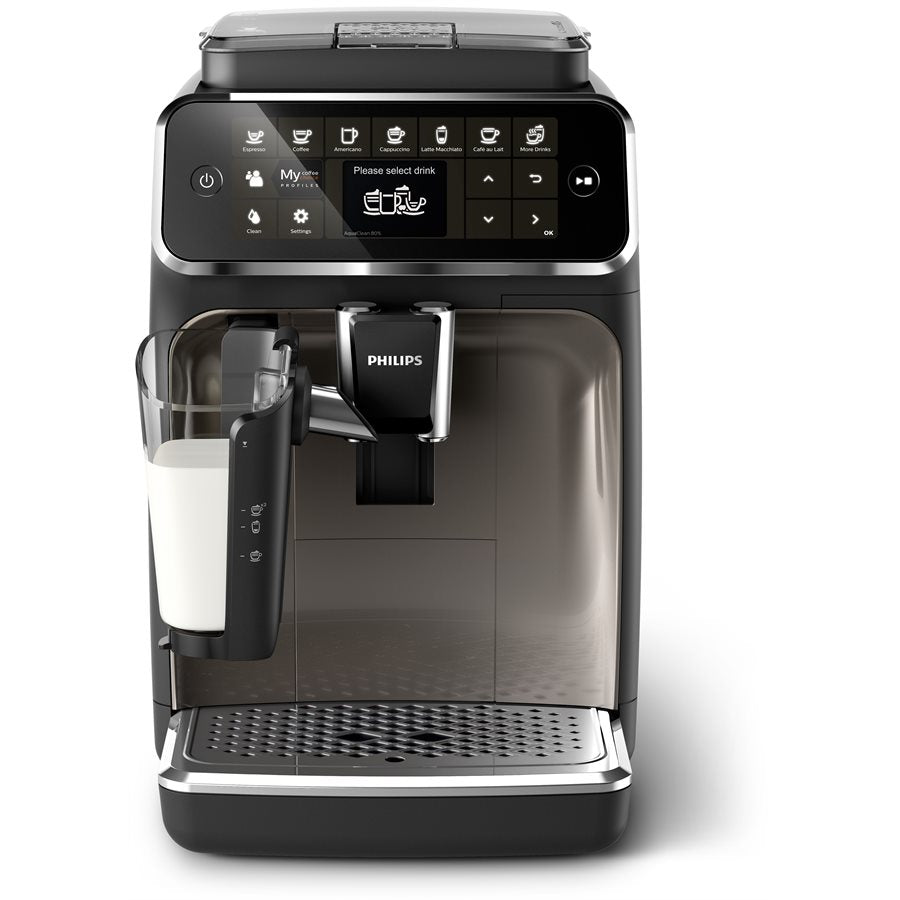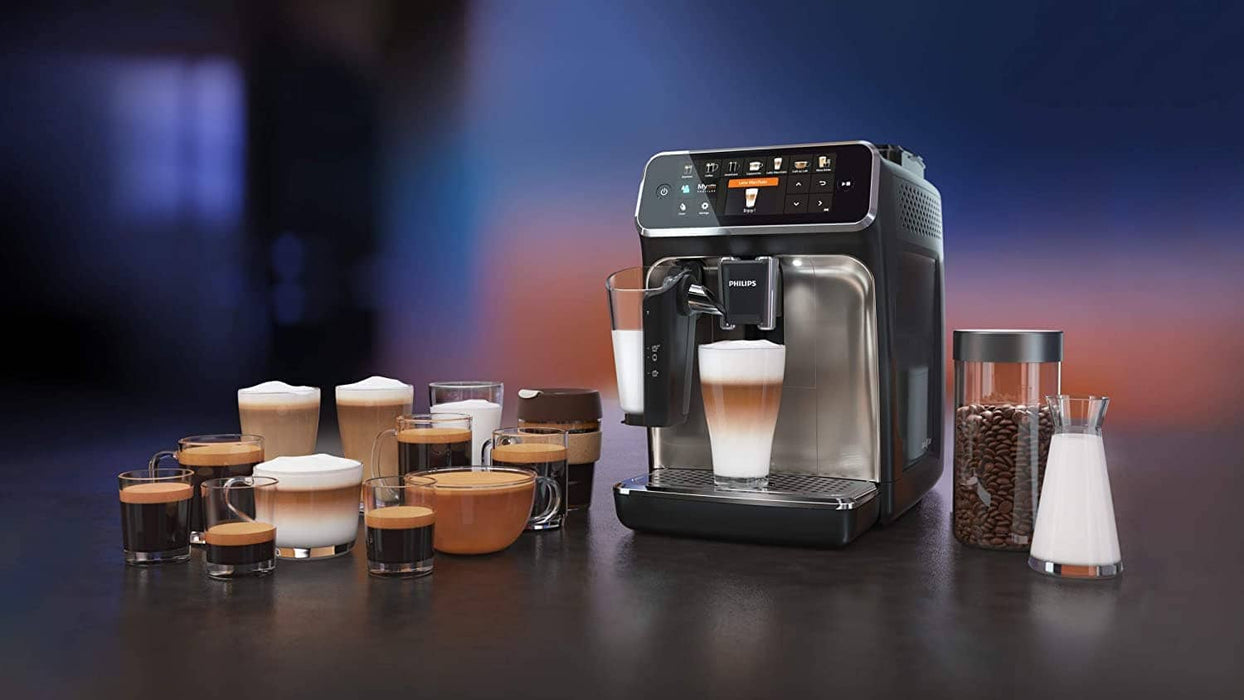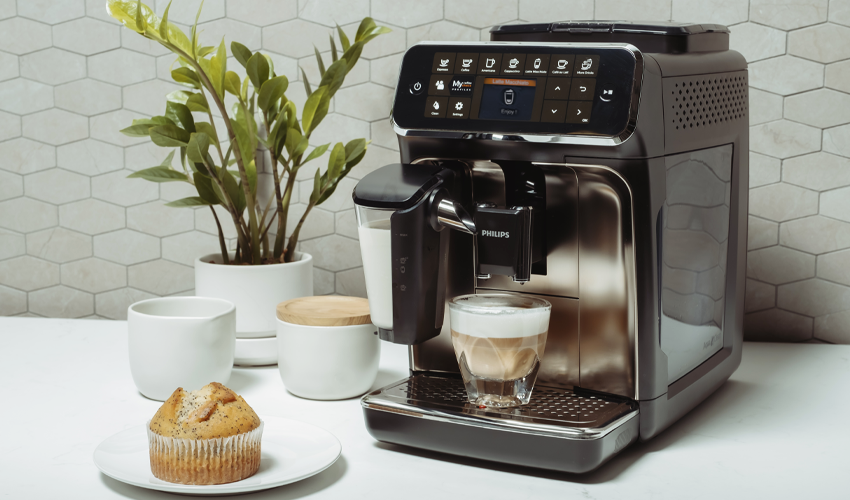#1: Philips LatteGo 5400

- Wide variety of drinks
- Advanced customization
- User profile options
#2: Philips LatteGo 4300

- Basic milk frother
- Small water tank
- Noisy grinder
I’ve always been a bit of a coffee lover, so when I decided to explore the Philips LatteGo series, I was excited to see what both the Philips LatteGo 5400 and 4300 had to offer. These machines are known for their user-friendly LatteGo milk system and versatile drink options. After spending some time with both models, I found that the Philips LatteGo 5400 stands out for a few key reasons. While both machines deliver on the basics, the added features of the 5400 make it a top choice for anyone wanting a fuller coffee experience. Here’s a closer look at my impressions of each model.

Philips LatteGo 5400 vs 4300: First Impressions and Setup
I unboxed both machines, the first thing I noticed was their sleek, compact designs. Philips clearly thought about both form and function in creating these models, and they’re both compact enough to fit comfortably on a kitchen counter. Setting up each machine was straightforward, with easy-to-follow instructions that made the process simple.
That said, the 5400 felt a bit more refined in terms of setup. It has a larger, more intuitive digital display, which made it easy to adjust settings and select drinks. The interface on the 4300 was functional, but I found myself naturally drawn to the polished and user-friendly layout on the 5400. Even at first glance, I could tell the 5400 was built to offer more flexibility.

Variety of Coffee Options: Philips LatteGo 5400 vs 4300
One of the big differences between the Philips LatteGo 5400 and 4300 is the range of coffee options. The 5400 offers 12 drink choices, covering a wide range of popular coffee drinks, while the 4300 has eight options. Both machines cover the basics—espresso, cappuccino, latte macchiato—but the 5400 includes specialty drinks like flat white and café au lait, which I genuinely enjoyed trying out.
With the 5400, I could easily experiment with different drinks depending on my mood or the time of day. It felt like having a small café at home, especially because it allowed me to customize drinks to fit my personal taste. The 4300 does a solid job with its options, but for someone who likes variety, the 5400’s broader range made a noticeable difference. If you enjoy experimenting with different styles of coffee, the 5400 is definitely worth considering.
Customization Features: Tailoring Each Cup to Your Taste
Both the Philips LatteGo 5400 and 4300 allow you to adjust the strength, temperature, and volume of your coffee. However, the 5400 takes customization further, offering more precise control over milk froth and coffee strength. I loved being able to tweak the settings to get just the right amount of froth for each drink, especially with milk-based drinks like lattes and cappuccinos.
The 4300 offers a good level of customization as well, but it has fewer fine-tuning options compared to the 5400. If you’re someone who likes to dial in your coffee settings to perfection, the 5400 offers a more satisfying level of control. This was particularly helpful when making drinks for guests, as I could adjust each drink based on their preferences without much hassle.
LatteGo Milk Frothing System: Philips LatteGo 5400 vs 4300
One of the standout features on both models is the LatteGo milk frothing system. I found it incredibly easy to use, as it doesn’t require any tubes and is quick to clean. The system automatically froths milk to create a creamy texture, perfect for lattes, cappuccinos, and more.
While the LatteGo system on both machines performs well, I noticed the 5400 delivered a slightly creamier, more consistent froth. This small difference might not seem significant, but for someone who loves a rich cappuccino, it adds an extra touch of quality. The milk carafe is dishwasher-safe, making cleanup a breeze, and I appreciated not having to deal with the complex cleaning routines that some machines require.
Philips LatteGo 5400 vs 4300: User Experience and Daily Convenience
it comes to usability, both the Philips LatteGo 5400 and 4300 are designed with convenience in mind. The digital displays on both models make it easy to navigate through drink options and customize settings. However, the 5400 has a larger, more intuitive display, which made daily use a bit smoother.
On the 5400, each drink icon is clear, and the additional touchscreen features make it faster to adjust settings or select drinks. This might seem like a minor detail, but for everyday use, having a clear and responsive interface really enhances the experience. It’s especially helpful in the mornings when I’m in a rush and just want to get my coffee without fussing with controls.
Cleaning and Maintenance: Philips LatteGo 5400 vs 4300
Both models are fairly easy to maintain, which is essential for someone like me who uses a coffee machine daily. The LatteGo system is a major advantage because it’s designed to be tube-free, minimizing the need for deep cleaning. Both the 5400 and 4300 have detachable milk carafes that can be rinsed or placed in the dishwasher, which made the daily cleaning routine simple and quick.
That said, the 5400 comes with additional cleaning alerts and reminders that made it easier to stay on top of maintenance. The 5400 provides a more structured descaling and cleaning routine, guiding you through each step, which I found helpful. Both machines also have a removable brew unit, which is easy to rinse out every week or so to keep things running smoothly.
Performance and Brew Quality: Philips LatteGo 5400 vs 4300
One of the things I appreciated most about the Philips LatteGo 5400 was the quality and consistency of each brew. The 5400’s grinder settings allowed me to fine-tune the grind for different drinks, giving me better control over the flavor profile. Both machines use a ceramic grinder, which maintains the quality of the coffee beans, but the 5400 offered a finer range of grind options, which elevated the overall coffee experience.
The 4300 also produces a great-tasting coffee, but for someone who appreciates a bit more depth and complexity in each cup, the 5400 delivers that extra touch. Whether it’s an espresso or a milk-based drink, the 5400 consistently produced rich, flavorful coffee that made each cup feel like a treat.
Energy Efficiency and Power-Saving Modes
Both the Philips LatteGo 5400 and 4300 are energy-efficient machines, with an auto-shutoff feature that powers down the machine after a set period of inactivity. This feature is especially useful if you’re like me and sometimes forget to turn off appliances in the morning rush.
The 5400, however, has more flexibility with its energy-saving settings. I was able to adjust the timing of the auto-shutoff, which helped save energy without interrupting my morning coffee routine. It’s a small detail, but one that adds a bit more convenience and peace of mind, especially if you’re environmentally conscious.
Value for Money: Which Model is Worth the Investment?
While both machines are excellent, the Philips LatteGo 5400 comes with a slightly higher price tag. Given the additional features and versatility, I found the 5400 to be worth the investment, especially if you’re looking for a machine that offers variety and quality in one package. The extra drink options, enhanced customization, and ease of use make it ideal for anyone who values a complete coffee experience at home.
The 4300 is still a great option if you’re looking for a simpler machine with fewer drink choices. It covers the basics and delivers good quality without as many advanced settings, making it a practical choice for those who don’t need extensive customization.

Product Review Conclusion: Philips LatteGo 5400 vs 4300
In the final comparison of Philips LatteGo 5400 vs 4300, the Philips LatteGo 5400 comes out on top. While both machines deliver high-quality coffee and are easy to use, the 5400’s additional drink options, enhanced customization, and more intuitive interface make it a better choice for coffee enthusiasts. For someone like me, who enjoys experimenting with different drinks and fine-tuning each cup, the 5400 offered an experience closer to what I would expect from a professional café.
The Philips LatteGo 4300 is still a solid machine, particularly for those who prefer a straightforward setup without as many choices. But if you’re someone who wants the full coffee experience with more options and control, the Philips LatteGo 5400 is the model to choose. It’s a versatile, high-quality machine that brings the joy of café-style coffee into your home with ease and precision.
Frequently asked questions and answers about the Philips LatteGo 5400 and 4300:
1. What are the main differences between the Philips LatteGo 5400 and 4300?
The main differences between the Philips LatteGo 5400 and 4300 are the number of drink options, customization settings, and display interface. The 5400 offers 12 pre-programmed drinks, compared to the 4300’s eight. Additionally, the 5400 has a larger, more intuitive digital display and allows for more precise customization of coffee strength, temperature, and milk froth.
2. Is the Philips LatteGo milk system easy to clean?
Yes, the LatteGo milk system on both the 5400 and 4300 is designed for easy cleaning. It’s a tube-free system, which minimizes areas where milk could get trapped. The milk carafe can be detached and rinsed under running water or placed in the dishwasher, making maintenance quick and hassle-free.
3. What types of drinks can the Philips LatteGo 5400 and 4300 make?
The Philips LatteGo 5400 can make 12 drinks, including espresso, cappuccino, latte macchiato, flat white, café au lait, and more. The 4300 offers eight drinks, covering the basics like espresso, cappuccino, and latte macchiato. The 5400 provides a broader range for those who want more drink variety.
4. Can I adjust the strength and temperature of the coffee?
Yes, both the Philips LatteGo 5400 and 4300 allow you to adjust coffee strength, temperature, and volume. The 5400, however, provides more precise control and customization options, letting you tailor each drink to your specific preferences.
5. How often do I need to clean and descale the machine?
Both the 5400 and 4300 will prompt you when it’s time to descale or clean the machine. Depending on your usage and water hardness, descaling is typically required every few months. The machines come with an AquaClean water filter, which can reduce the need for frequent descaling.
6. Are these machines compatible with ground coffee and coffee beans?
Yes, both the Philips LatteGo 5400 and 4300 have a bypass doser for pre-ground coffee, allowing you to use either whole beans or ground coffee. This feature is particularly convenient if you occasionally want to use decaf or a specific blend.
7. How long does it take to brew a coffee with the Philips LatteGo machines?
Both machines are fast and efficient, heating up within a minute or two. The brewing time for an espresso or regular coffee is typically under a minute, while milk-based drinks may take slightly longer due to the frothing process.
8. Do the Philips LatteGo 5400 and 4300 have energy-saving features?
Yes, both models include energy-saving features such as an automatic shut-off function. The 5400 offers more customizable options for the shut-off timing, allowing you to adjust it to your daily routine.
9. Is the Philips LatteGo 5400 worth the higher price compared to the 4300?
If you value a wider range of drink options, enhanced customization, and a more user-friendly display, then the Philips LatteGo 5400 may be worth the additional cost. However, if you only need basic coffee options and don’t require advanced customization, the 4300 offers great quality at a more affordable price.
10. How does the grinder perform on the Philips LatteGo machines?
Both the Philips LatteGo 5400 and 4300 feature a ceramic grinder with multiple grind settings. The grinder is durable and helps preserve the coffee’s flavor by avoiding overheating, ensuring a fresh, consistent grind each time.
11. Do these machines support dual coffee spouts for brewing two drinks at once?
Yes, both the 5400 and 4300 have dual coffee spouts, allowing you to brew two espresso shots or two coffees simultaneously. This feature is convenient if you have multiple coffee drinkers in the household.
12. Can I save my favorite coffee settings on these machines?
Yes, both models allow you to save personalized coffee settings. The Philips LatteGo 5400 offers more detailed customization and lets you save multiple profiles, which is helpful for households with different coffee preferences.
13. What is the warranty on the Philips LatteGo 5400 and 4300?
Philips generally offers a two-year warranty on both the LatteGo 5400 and 4300, covering parts and labor for manufacturing defects. Be sure to check with the retailer or Philips’ official website for specific warranty details in your region.
14. How much space do these machines require on the countertop?
Both models are compact and designed to fit comfortably on most countertops. Their approximate dimensions are 9.6 x 17 x 14.6 inches (width, depth, height), so make sure to measure your available space to ensure a good fit.
15. How noisy are the Philips LatteGo 5400 and 4300 when brewing?
Both machines produce a low level of noise during grinding and brewing, similar to most automatic espresso machines. The sound level is generally manageable, but if you’re sensitive to noise, you might notice it during the grinding process.
